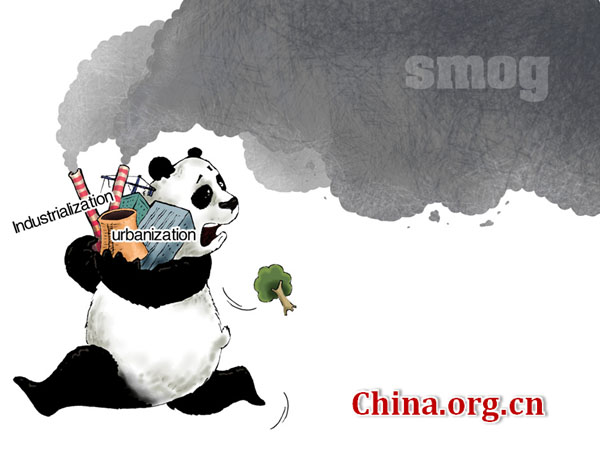Smog and the energy structure
china.org.cn / chinagate.cn by Zhu Ming et al., November 24, 2014 Adjust font size:
|
[By Zhai Haijun/China.org.cn] |
China's severe atmospheric smog problem has already attracted the attention of the government at various levels. Specialists and experts have reached a consensus that the problem has to be solved at the root. The root cause of the smog, in our understanding, is the energy structure. Using coal as the main fuel is the critical factor causing smog. Currently in China, coal-fired power accounts for about 70 percent of electricity.
To ease the smog problems, China has taken measures to reduce the use of coal, and develop renewable energy sources, including water, solar and wind power, and nuclear power. It was stipulated in the country's Twelfth Five-year Plan that the proportion of coal consumption in the energy structure must be reduced from 73.45 percent in 2010 to 66.37 percent and 61.74 percent in 2015 and 2020 respectively.
However, owing to China's large population and large economy, the total energy demand is also increasing along with economic growth. Therefore, there will continue to be a high demand for coal. According to the National Development and Reform Commission's National Energy Administration, coal production will reach 4.1 billion tons in 2015. The China National Coal Association also predicted in November 2013 that China's coal consumption will reach 4.8 billion tons by 2020.
Such a huge consumption of coal will eventually produce huge amounts of sulfur dioxide (initially estimated at 257 million tons), nitrogen oxide (129 million tons) and coal dust (2.33 billion tons) will be huge; and the carbon dioxide discharged is also considerable, some 7-8 billion tons. If we don't take strategic measures, China will not only face severe air pollution such as smog and acid rain, but also become a bigger contributor to global warming.
China has a large amount of coal resources. If underground coal gasification (UCG) can be used, where the coal is burnt underground in a controllable way to produce combustible gas which is then piped to the surface for power generation and liquid synthetic fuel and chemical raw material, it would be a revolutionary reform that would change thousands of years of conventional coal mining in China into chemical extraction. The development of UCG would probably help China to address the problem of air pollution fundamentally and to reduce energy imports.


